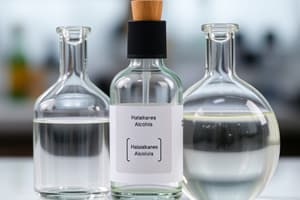Podcast
Questions and Answers
What type of carbon atom is a hydroxyl group attached to in a tertiary alcohol?
What type of carbon atom is a hydroxyl group attached to in a tertiary alcohol?
- Quaternary carbon atom with four alkyl groups
- Secondary carbon atom with a substituent
- Tertiary carbon atom with three alkyl groups (correct)
- Primary carbon atom
Which physical property of alcohols is influenced by hydrogen bonding?
Which physical property of alcohols is influenced by hydrogen bonding?
- Solubility in water
- Viscosity (correct)
- Density
- Boiling point
What is the suffix used in IUPAC nomenclature to indicate an alcohol?
What is the suffix used in IUPAC nomenclature to indicate an alcohol?
- -ene
- -ane
- -al
- -ol (correct)
What is the product of the combustion reaction of an alcohol?
What is the product of the combustion reaction of an alcohol?
What is the reaction between an alcohol and a carboxylic acid to form a compound?
What is the reaction between an alcohol and a carboxylic acid to form a compound?
What industry uses alcohols as solvents?
What industry uses alcohols as solvents?
Flashcards are hidden until you start studying
Study Notes
Classification of Alcohols
- Primary (1°) alcohols: The hydroxyl group (-OH) is attached to a primary carbon atom (one alkyl group).
- Secondary (2°) alcohols: The hydroxyl group (-OH) is attached to a secondary carbon atom (two alkyl groups).
- Tertiary (3°) alcohols: The hydroxyl group (-OH) is attached to a tertiary carbon atom (three alkyl groups).
Physical Properties of Alcohols
- Boiling point: Increases with increasing molecular weight and branching.
- Solubility: Alcohols are polar, so they are soluble in water and other polar solvents.
- Viscosity: Alcohols have higher viscosity than corresponding alkanes due to hydrogen bonding.
Nomenclature of Alcohols
- IUPAC rules:
- Parent chain: longest chain with the hydroxyl group.
- Suffix:
-olreplaces the-eending of the parent alkane. - Numbering: starts from the hydroxyl group.
- Common names: derived from the alkyl group and the suffix
-ol.
Reactions of Alcohols
- Combustion: Alcohols undergo complete combustion to produce CO2 and H2O.
- Dehydration: Alcohols lose water to form alkenes.
- Oxidation: Alcohols are oxidized to aldehydes or ketones.
- Esterification: Alcohols react with carboxylic acids to form esters.
Uses of Alcohols
- Solvents: Alcohols are used as solvents in various industries (pharmaceutical, cosmetic, etc.).
- Fuels: Alcohols can be used as biofuels or additives to gasoline.
- Pharmaceuticals: Alcohols are used as active ingredients or excipients in drug formulations.
- Antiseptics: Alcohols are used as disinfectants and antiseptics.
Studying That Suits You
Use AI to generate personalized quizzes and flashcards to suit your learning preferences.



